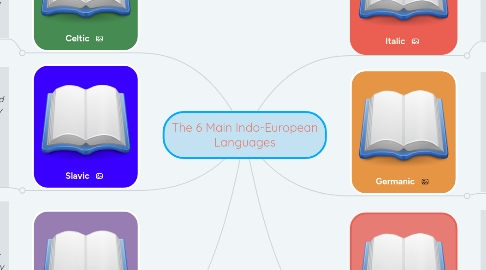
1. Celtic
1.1. This branch holds two sub-branches: Continental Celtic and Insular Celtic. Celtic-speaking tribes had spread from what today is known as Germany, Austria, and Western Czech Republic in almost all directions. The only Celtic languages still used (Irish Gaelic, Scottish Gaelic, Welsh and Breton) all come from Insular Celtic.
1.1.1. Languages coming from this branch still on use
1.1.1.1. Irish Gaelic
1.1.1.2. Scottish Gaelic
1.1.1.3. Welsh
2. Slavic
2.1. This branch contains two sub-branches: Baltic and Slavic. During the late Bronze Age, the Balts' territory may have stretched from around western Poland and after they occupied a small region along the Baltic Sea. Only two Baltic languages survive today: Latvian and Lithuanian. A large number of Slavic languages survive today, such as Bulgarian, Czech, Croatian, Polish, Serbian, Slovak, Russian, and many others.
2.1.1. Languages coming from this branch still on use
2.1.1.1. Russian
2.1.1.2. Bulgarian
2.1.1.3. Macedonian
2.1.1.4. Slovenia
2.1.1.5. Serbian
2.1.1.6. Croatian
3. Indic
3.1. The Indo-Aryan or Indic languages are a major language family of South Asia. They constitute a branch of the Indo-Iranian languages, themselves a branch of the Indo-European languages. In the early 21st century, Indo-Aryan languages were use by more than 800 million people, primarily in India, Bangladesh, Nepal, Pakistan and Sri Lanka. There are large immigrant and expatriate Indo-Aryan-speaking communities in Northwestern Europe, Western Asia, North America and Australia.
3.1.1. Languages coming from this branch still on use
3.1.1.1. Sanskirt
3.1.1.2. Hindi
3.1.1.3. Bengali
3.1.1.4. Tamil
4. Italic
4.1. This branch was predominant in the Italian peninsula. Latin, the most famous language in this group, was originally a relatively small local language spoken by pastoral tribes living in small agricultural settlements in the center of the Italian peninsula. Rome was responsible for the growth of Latin in ancient times.
4.1.1. Languages coming from this branch still on use
4.1.1.1. Italian
4.1.1.2. Spanish
4.1.1.3. Romanian
4.1.1.4. French
4.1.1.5. Portuguese
5. Germanic
5.1. The Germanic branch is divided in three sub-branches: East Germanic, currently extinct; North Germanic, containing Old Norse, the ancestor of all modern Scandinavian languages; and West Germanic, containing Old English, Old Saxon, and Old High German. Dutch, English, Frisian, and Yiddish are some examples of modern survivors of the West Germanic sub-branch.
5.1.1. Languages coming from this branch still on use
5.1.1.1. English
5.1.1.2. German
5.1.1.3. Swedish
5.1.1.4. Norwegian
5.1.1.5. Icelandic
5.1.1.6. Dutch
5.1.1.7. Danish
6. Iranian
6.1. The Iranian or Iranic languages[2][3] are a branch of the Indo-Iranian languages in the Indo-European language family that are spoken natively by the Iranian peoples. The Iranian languages are grouped in three stages: Old Iranian (until 400 BC), Middle Iranian (400 BC – 900 AD), and New Iranian (since 900 AD). The two directly attested Old Iranian languages are Old Persian (from the Achaemenid Empire) and Old Avestan (the language of the Avesta).
6.1.1. Languages coming from this branch still on use
6.1.1.1. Iranian
6.1.1.2. Persian
6.1.1.3. Pashto
6.1.1.4. Kurdish
6.1.1.5. Balochi
